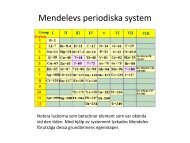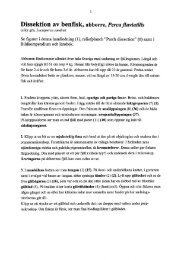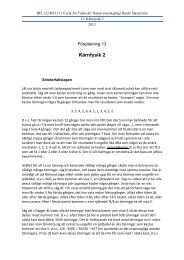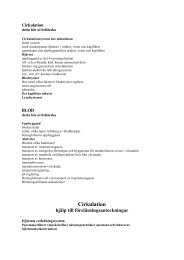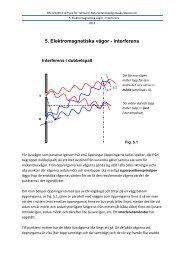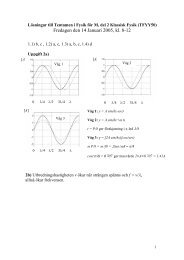Molekylmodellering med Chem3D - IFM
Molekylmodellering med Chem3D - IFM
Molekylmodellering med Chem3D - IFM
Create successful ePaper yourself
Turn your PDF publications into a flip-book with our unique Google optimized e-Paper software.
<strong>Molekylmodellering</strong> <strong>med</strong> <strong>Chem3D</strong><br />
Inledning<br />
SS/01-05-05<br />
Det finns ett antal förekommande beräkningsmetoder för att studera molekylers<br />
tredimensionella struktur <strong>med</strong> datorer. Dels finns molekylmekanik metoder (MM) där<br />
klassiska fysiklagar används som beräkningsgrund, dvs man tar främst hänsyn till<br />
atomkärnorna och till mindre del elektronstrukturen. Dels finns kvantmekaniska metoder<br />
(QMM) som utgår från Schrödinger ekvationen och molekylens elektronstruktur. QMM<br />
indelas vidare i s.k. semi-empiriska och ab initio metoder. De senare metoderna bygger<br />
mindre på experimentella data och kräver mer "datakraft" och lämpar sig därför mer för<br />
molekyler <strong>med</strong> mindre än ≈ 100 atomer.<br />
MM (Molecular Mechanics) lämpar sig dock för större molekylmassor (t.ex. enzymer) och<br />
bygger till stor del på experimentella data, såsom bindningsavstånd, vinklar mm.<br />
Energiminimering används för att minimera alla interaktioner i en molekyl så att den<br />
stabilaste (lägst energi) strukturen antas. Molekyl dynamik (MD) där atomerna sätts i rörelse<br />
så att de fritt får interagera <strong>med</strong> andra atomer och inta ett jämviktsläge. Om man enbart<br />
använder sig av MM är det stor risk att strukturen hamnar i ett lokalt minimum (se figur). Om<br />
man startar <strong>med</strong> en struktur i energidiagrammmet kan den hamna i någon av de högre<br />
energidalarna.. Det skulle inte vara den mest stabila strukturen för denna molekyl utan<br />
molekylen skulle fastna i ett s.k. lokalt minimum. Det kan undvikas om man låter molekylen<br />
anta en annan utgångsstruktur eller att använda MD (nedre figuren). Molekylen tillåts inta en<br />
annan utgångspunkt eller kan att vandra utefrer den streckade linjen <strong>med</strong> hög energi och leta<br />
upp det globala energiminimat som finns i lägsta energidalen. Det kan vara svårt att veta om<br />
man nått det globala minimat efter enbart en energiminimering.<br />
Energy<br />
MIN<br />
A<br />
MD<br />
B<br />
C
Laborationsförsök<br />
I datalaborationerna är det tänkt att laboranten ska sätta sig in i programmen ChemDrawPro<br />
(ritprogram) och <strong>Chem3D</strong> (modelleringsprogram) genom att rita upp någon molekyl i<br />
ChemDraw överföra denna i <strong>Chem3D</strong> samt pröva några av de olika möjligheter som<br />
programmet <strong>med</strong>ger. Främst kommer energiminimering användas men även molekyldynamik..<br />
Minimeringsberäkningarna görs i vakuum och blir därför inte helt tillförlitliga, men<br />
i jämförelse <strong>med</strong> opolära lösnings<strong>med</strong>el blir dock skillnaderna små.<br />
Följande moment avses ingå under labkursen:<br />
1. Rita 2-dimensionella strukturer av organisk komplicerade stereostrukturer i<br />
ritprogrammet Chem Draw.<br />
2. Överföra strukturer från Chem Draw eller rita strukturer direkt i Chem 3D för att<br />
visualisera strukturer tredimensionellt. (obs kontrollera att inte stereokemi ändrats!)<br />
3. Energi minimera uppritade strukturer. Modifiera konformationer för att påvisa lokala<br />
minima och globala minima. Ur olika värden påvisa vilka effekter som bidrar till en<br />
molekyls totala energi.<br />
4. Mäta bindningavstånd och vinklar mellan atomerna från modellerad molekyl.<br />
5. Korrelera bindningsvinklar mellan väten till kopplingskonstanters storlek från<br />
upptagna NMR spektra.<br />
Programmen är relativt användarvänliga och enkla att förstå, men till er hjälp finns pärmar<br />
<strong>med</strong> ledning och tutorials för de båda programmen. Framifrån : ChemDraw (ritprogrammet)<br />
och Bakfrån <strong>Chem3D</strong> (minimeringsprogrammet). Vidare lärarhjälp.<br />
Uppgifter:<br />
A. Rita i ChemDraw en komplicerad molekylstruktur tvådimensionellt så att alla stereogena<br />
kols bindningar har rätt riktning tredimensionellt.<br />
Välj två av dessa: sackaros, adenine, estradiol, vitamin A, morfin. Rita ut strukturen för<br />
redovisning.<br />
Överför strukturen till Chem 3D (klipp och klistra) och se molekylen tredimmensionellt.<br />
Energiminimerea och välj lämpligt sätt att presentera molekylen utskriven (ej färg).<br />
B. Med Chem 3D energiminimeras ett lämligt substituerat cyklohexan-derivat. Olika<br />
konformationer jämförs t.ex. Twisted-boat och Chair. Jämför och kommentera de olika<br />
konformationernas värden. Diskuteras gärna <strong>med</strong> andra gruppers resultat på liknande<br />
isomera cyklohexan-derivat. Vilken av nedan strukturer tror ni har mest stabil och minst<br />
stabil stolform ? Tag fram ert resultat och jämför <strong>med</strong> andra gruppers resultat.<br />
1. Grp A+D: cis- och trans-1,2-dimetylcyklohexan<br />
2. Grp B+E : cis- och trans-1,3-dimetylcyklohexan<br />
3. Grp C+F: cis- och trans-1,4-dimetylcyklohexan<br />
Rita upp strukturen. Minimera strukturen och anteckna erhållna värden på stretch, bend,<br />
stretch-bend, torsion, non-1,4-vdW, 1,4-vdW, dipol/dipol och total energi.<br />
Chair-konformationen har generellt lägst energi. Flytta om några kol och se om ni kan hitta<br />
olika lokala minima. Ett sådant som man ofta kan hitta är twist-boat konformation<br />
Vid minimeringarna kan man använda de utgångsvärden som är angivna för MM2: minimize<br />
energy.
Några tips (<strong>Chem3D</strong>)<br />
• Det är enklare att se strukturen om man gömmer alla väten (Tools: Show H´s)<br />
• Vill man invertera ett stereocenter kan man göra detta <strong>med</strong> genom att markera atomen och<br />
använda Tools: Invert. Vid överföring från ChemDraw till <strong>Chem3D</strong> måste stereocenter<br />
kontrolleras, eftersom det ibland händer att en godtycklig stereokemi väljs.<br />
• Under View: Preferences kan man ändra utseendet på molekylen (ball and sticks är att föredra!)<br />
C: <strong>Molekylmodellering</strong> kan användas för att förut se stereoselektivitet. Föreslå från den<br />
tvådimensionella strukturen nedan hur alla tre dubbelbindningarna kommer att<br />
epoxideras <strong>med</strong> MCPBA (meta-chlorperbenzoic acid). Gör den tredmensionella<br />
strukturen, energiminimera och avgör om det förra antagandet stämmer då du ser den<br />
tredimensionellt. Redovisa den troliga produkten tvådimensionellt i ChemDraw.<br />
O<br />
O<br />
MCPBA<br />
Vid senare laborationer:<br />
Ett senare mål är att göra en konformationsminimering på organiska föreningar från<br />
laborationer, som strukturidentifierats <strong>med</strong> NMR. Erhållna kopplingskonstanter från NMR<br />
spektrat kan ur Kaplus formeln (se spektroskopibokem) ge vinklar som jämförs <strong>med</strong><br />
bindningsvinklar ur den <strong>med</strong> <strong>Chem3D</strong> byggda och energiminimerade strukturen.<br />
Redovisning:<br />
A. Namn på vald struktur, två-dimensionell struktur samt tre-dimensionellt minimerad<br />
struktur.<br />
B. .För resp. cis- och trans-struktur redovisas tredimensionell minimerad struktur för chair,<br />
twisted-boat och ev. boat-form, och data för resp. konformation. Även kort diskussion<br />
kring struktur, konformation och erhållna energivärden. Via egna funderingar och andra<br />
gruppers resultat, vilken struktur är stabilast ? Stämmer egna antaganden <strong>med</strong> resultatet ?<br />
C. Uppritad utgångsstruktur och den trriepoxiderade strukturen där epoxidernas<br />
tredimensionella orientering inritas på utgångsstrukturen. Minimerat totalvärde och<br />
tredimensionell struktur på utgångsstruktur och produkt redovisas även.
COMPUTATIONAL CHEMISTRY<br />
Computational chemistry extends beyond thetraditional boundaries separating chemistry from physics,<br />
biology, and computer science. Though pioneering work in this area predates by decades the 1980<br />
debut of its namesake journal, the Journal of Computational Chemistry, computational chemistry, as a<br />
distinct area of research, is relatively new. It allows the exploration of molecules through the use of a<br />
computer in cases when an actual laboratory investigation may be inappropriate, impractical, or<br />
impossible. As an adjunct to experimental chemistry, its significance continues to be enhanced by<br />
explosive increases in computer speed and power.<br />
Aspects of computational chemistry include molecular modeling, computational methods, and<br />
Computer Aided Molecular Design (CAMD), as well as chemical databases, and organic<br />
synthesis design.<br />
While a number of different definitions have been proposed, the definition offered by Lipkowitz and<br />
Boyd of computational chemistry as “those aspects of chemical research that are expedited or rendered<br />
practical by computers” is perhaps the most inclusive.<br />
Molecular modeling, while often taken to include computational methods, can be thought of as the<br />
rendering of a 2D or 3D model of a molecule‘s structure and properties. Computational methods, on<br />
the other hand, calculate the structure and property data necessary to render the model. Within a<br />
modeling program, such as <strong>Chem3D</strong>, computational methods are referred to as computation engines,<br />
while geometry engines and graphics engines render the model.<br />
Only within the past few years has it become possible to perform genuinely useful molecular<br />
computations with a desktop personal computer. <strong>Chem3D</strong> supports a number of powerful<br />
computational chemistry methods on the desktop in addition to its extensive visualization options. The<br />
rest of this chapter will provide an introduction to the computational methods available through<br />
<strong>Chem3D</strong>.<br />
COMPUTATIONAL METHODS OVERVIEW<br />
Computational chemistry encompasses a variety of mathematical methods which fall into two broad<br />
categories: molecular mechanics and quantum mechanics.<br />
Molecular mechanics applies the laws of classical physics to molecular nuclei without explicit<br />
consideration of electrons.<br />
Quantum mechanics relies on the Schrödinger<br />
equation to describe a molecule with explicit<br />
treatment of electronic structure. Generally,<br />
quantum mechanical methods can be<br />
subdivided into two classes: ab initio and<br />
semiempirical, making a total of three<br />
generally accepted method classes, as shown<br />
beside.<br />
All three classes are available through <strong>Chem3D</strong>. The molecular mechanical MM2 method, and the<br />
semiempirical Extended Hückel, MINDO/3, MNDO, MNDO-d, AM1 and PM3 methods are directly<br />
available from within <strong>Chem3D</strong> and CS MOPAC, while ab initio methods are available through<br />
<strong>Chem3D</strong>’s Gaussian interface. An individual computational method may also be referred to as a<br />
theory.<br />
Uses of Computational Methods<br />
Computational methods calculate the potential energy surfaces of molecules. The potential energy<br />
surface (PES) can be considered to be the embodiment of the forces of interaction among atoms in a<br />
molecule; from the PES, structural and chemical information about a molecule can be derived. While<br />
the methods differ in the way the surface is calculated, and in the molecular properties that can be<br />
derived from the energy surface, they generally perform the following basic types of calculations:<br />
• single point energy calculation, which is the energy of a given spacial arrangement of the atoms in<br />
a model, or more precisely, the value of the PES for a given set of atomic coordinates.
• geometry optimization, which is a systematic modification of the atomic coordinates of a model<br />
resulting in a geometry where the net forces on the structure sum to zero, or in other word, a 3dimensional<br />
arrangement of atoms in the model representing a local energy minimum (a stable<br />
molecular geometry to be found without crossing a conformational energy barrier).<br />
• property calculation, which predicts certain physical and chemical properties, such as charge,<br />
dipole moment and heat of formation. Additionally such methods may be employed to perform more<br />
specialized functions, such as conformational searches and molecular dynamics simulations.<br />
Choosing the Best Method<br />
Not all types of calculations are possible for all methods, and no one method is best for all purposes.<br />
For any given application, each method will pose advantages and disadvantages. Choice of method<br />
will depend on a number of factors, including the nature of the molecule, the type of information<br />
sought, the availability of applicable experimentally determined parameters (as required by some<br />
methods), as well as more practical matters of available computer resources and time. The three most<br />
important of the these criteria are:<br />
1. Model size: The size of a model can be a serious limiting factor for a particular method. In general,<br />
the limiting number of atoms in a molecule increases by approximately one order of magnitude<br />
between method classes from ab initio to molecular mechanics. Accordingly ab initio is limited to tens<br />
of atoms, semiempirical to hundreds, and molecular mechanics to thousands.<br />
2. Parameter Availability: Some methods depend on experimentally determined parameters to<br />
perform computations. If the model contains atoms for which the parameters of a particular method<br />
have not been derived, that method may produce invalid predictions. Molecular mechanics, for<br />
instance, relies on parameters to define a force-field. Any particular force-field is only applicable to<br />
the limited class of molecules for which it is parametrized.<br />
3. Computer resources: Requirements increase in the following manner relative to the size of the<br />
model for each of the methods.<br />
Ab initio : The time required for performing computations increases on the order of N 4 , where N is the<br />
number of atoms in the model.<br />
Semiempirical: The time required for computation increases as N 3 or N 2 , where N is the number of<br />
atoms in the model.<br />
MM2: The time required for performing computations increases as N 2 , where N is the number of<br />
atoms.<br />
In general, molecular mechanical methods are computationally less expensive than quantum<br />
mechanical methods. The suitability of each general method for particular applications can be<br />
summarized as follows.<br />
Molecular Mechanics Methods Applications<br />
Summary<br />
Molecular mechanics, in <strong>Chem3D</strong>, can successfully be applied to:<br />
• Systems containing thousands of atoms.<br />
• Organic, oligonucleotides, peptides, and saccharides.<br />
• Gas phase only (for MM2) Useful techniques available using MM2 methods include:<br />
• Energy Minimization for locating stable conformations.<br />
• Single point energy calculations for comparing conformations of the same molecule.<br />
• Searching conformational space by varying a single dihedral angle.<br />
• Studying molecular motion using Molecular Dynamics.<br />
Quantum Mechanical Methods Applications<br />
Summary<br />
The semiempirical methods available in <strong>Chem3D</strong> and CS MOPAC can be successfully applied to:<br />
• Systems containing up to 60 heavy atoms and 120 total atoms (in CS MOPAC).<br />
• Organic, organometallics, and small oligomers (peptide, nucleotide, saccharide).<br />
• Gas phase or implicit solvent environment.<br />
• Ground, transition, and excited states.<br />
Ab initio methods (available through the Gaussian interface) can be successfully applied to:
• Systems containing up to ca. 30 atoms.<br />
• Organic, organometallics, and molecular fragments (e.g. catalytic components of an enzyme).<br />
• Gas or implicit solvent environment.<br />
• Study ground, transition, and excited states (certain methods).<br />
Useful information determined by quantum mechanical methods includes:<br />
• Molecular orbital energies, and coefficients.<br />
• Heat of Formation for evaluating conformational energies.<br />
• Partial atomic charges calculated from the molecular orbital coefficients.<br />
• Electrostatic potential.<br />
• Dipole moment.<br />
• Transition-state geometries and energies.<br />
• Bond dissociation energies.<br />
Summary of Method types:
Potential Energy Surfaces<br />
A potential energy surface (PES) can describe:<br />
• either a molecule or ensemble of molecules having constant atom composition (ethane, for example),<br />
or a system where a chemical reaction occurs.<br />
• relative energies for conformers (e.g. eclipsed and staggered forms of ethane).<br />
NOTE: It is important to keep in mind that different potential energy surfaces are generated for:<br />
• molecules having different atomic composition (ethane and chloroethane).<br />
• molecules in excited states than for the same molecules in their ground states.<br />
• molecules with identical atomic composition but with different bonding patterns, such as<br />
propylene and cyclopropane.<br />
Points of interest on a Potential Energy surface.<br />
The true representation of a model’s potential<br />
energy surface is a multi-dimensional surface<br />
whose dimensionality increases with the<br />
number of independent variables. Since each<br />
atom has three<br />
independent variables (x, y, z coordinates),<br />
visualizing a surface for a many-atom model is<br />
impossible. However, we can generalize this<br />
problem by examining any 2 independent<br />
variables, such asthe x and y coordinates of an<br />
atom, as shown below:<br />
Potential Energy Surface Representing 2 Variables<br />
The main areas of interest on a potential energy surface are the extrema indicated above by arrows.<br />
The most stable conformation appears at the extremum where the energy is lowest. This extremum is<br />
called the global minimum. There is only one global minimum for a molecule; however, for all but<br />
the simplest molecules, there are additional low energy extrema, ter<strong>med</strong> local minima. Minima are<br />
defined by regions of the PES where a change in geometry.<br />
The last extremum of interest is at a point between two low energy extrema and is ter<strong>med</strong> a saddle<br />
point. The saddle point is defined as a point on the potential energy surface at which there is an<br />
increase in energy in all directions except one, and for which the slope (first derivative) of the surface<br />
is zero.<br />
NOTE: At the energy minimum, the energy is not zero; the first derivative (gradient) of the energy with<br />
respect to geometry is zero.<br />
All the minima on a potential energy surface of a molecule represent stable stationery points where the<br />
forces on atoms sum to zero. The global minimum represents the most stable conformation; the local<br />
minima, less stable conformations; and the saddle points represent transition conformations between<br />
minima.<br />
Single Point Energy Calculations<br />
Single point energy calculations can be used tocalculate properties of the current geometry of a model.<br />
The values of these properties are dependent on where the model currently lies on the potential<br />
surface. Further:<br />
1. A single point energy calculation at a global minimum provides information about the model<br />
in its most stable conformation.<br />
2. A single point calculation at a local minimum provides information about the model in one of<br />
many stable conformations.
3. A single point calculation at a saddle point provides information about the transition state of<br />
the model.<br />
4. A single point energy calculation at any other point on the potential energy surface provides<br />
information about that particular geometry, not a stable conformation or transition state.<br />
Single point energy calculations may be perfor<strong>med</strong> either before or after performing an optimization,<br />
though.<br />
NOTE: Since different methods rely on different assumptions about a given molecule, values derived<br />
from different methods should NOT be compared!<br />
Geometry Optimization<br />
Geometry optimization is a technique used for locating a stable conformation of a model. As a general<br />
rule, this should be perfor<strong>med</strong> before performing additional computations or analyses of a model.<br />
Locating global and local energy minima is often accomplished through energy minimization;<br />
locating a saddle point is referred to as optimizing to a transition state.<br />
The ability of a geometry optimization to converge to a minimum will depend on the starting<br />
geometry, the potential energy function used, and the settings for a minimum acceptable gradient<br />
between steps (convergence criteria).<br />
Geometry optimizations are iterative and begin at some starting geometry. First, the single point<br />
energy calculation is perfor<strong>med</strong> on the starting geometry. Then the coordinates for some subset of<br />
atoms are changed and another single point energy calculation is perfor<strong>med</strong> to determine the energy of<br />
that new conformation. The first or second derivative of the energy (depending on the method) with<br />
respect to the atomic coordinates then determines how large and in what direction the next increment<br />
of geometry change should be. Then the change is made.<br />
Following the incremental change, the energy and energy derivatives are again determined and the<br />
process continues until convergence is achieved, at which point the minimization process terminates.<br />
The figure below illustrates some concepts of<br />
minimization. For simplicity, this plot shows a<br />
single independent variable plotted in two<br />
dimensions.<br />
1. The starting geometry of the model will determine which minimum is reached. For instance, starting<br />
at (b), minimization will result in geometry (a), which is the global minimum. However, starting at (d)<br />
will lead to geometry (f), which is a local minimum.<br />
2. The proximity to a minimum, but not a particular minimum, can be controlled by specifying a<br />
minimum gradient that should be reached. Geometry (f), rather than geometry (e), can be reached by<br />
decreasing the value of the gradient where the calculation ends.<br />
3. Often, if a convergence criterion (energy gradient) is too lax, a first-derivative minimization can<br />
result in a geometry that is near a saddle point. This occurs because the value of the energy gradient<br />
near a saddle point, as near a minimum, is very small. For example, at point (c), the derivative of the<br />
energy is 0, and as far as the minimizer is concerned, point (c) is a minimum. First derivative<br />
minimizers cannot, as a rule, surmount saddle points to reach another minimum.<br />
There are several steps which may be taken to ensure that a minimization has not resulted in a saddle<br />
point.<br />
1. The geometry can be altered slightly and another minimization perfor<strong>med</strong>. The new starting<br />
geometry might result in either (a), or (f) in a case where the original one led to (c).<br />
2. The Dihedral Driver (Macintosh only. See Chapter 10, MM2 Computations, for more information.)<br />
can be employed to search the conformational space of the model.
3. A molecular dynamics simulation can be run, which will allow small potential energy barrier to be<br />
crossed. After completing the molecular dynamics simulation, individual geometries can then be<br />
minimized and analyzed. (For further information, see Chapter 10, MM2 Computations.)<br />
Property Calculations<br />
From the PES, many molecular properties can be calculated. The properties which can be calculated<br />
with the computational methods available through <strong>Chem3D</strong> include: steric energy, heat of formation,<br />
dipole moment, charge density, COSMO solvation in water, electrostatic potential, electron spin<br />
density, hyperfine coupling constants, atomic charges, polarizability, and others, such as IR vibrational<br />
frequencies. These properties are discussed in more detail in the following chapters.<br />
MOLECULAR MECHANICS THEORY IN BRIEF<br />
Molecular mechanics describes the energy of a molecule in terms of a set of classically derived energy<br />
functions. The potential energy functions and the parameters used for their evaluation are known as a<br />
“force-field”. Molecular mechanical methods are based on the following principles:<br />
4. Nuclei and electrons are lumped together and treated as unified atom-like particles.<br />
5. Atom-like particles are typically treated as spheres.<br />
6. Bonds between particles are viewed as harmonic<br />
7. Non-bonded interactions between these particles are treated using potential functions<br />
derived using classical mechanics.<br />
8. Individual potential functions are used to describe the different interactions: bond<br />
stretching, angle bending, and torsional (bond twisting) energies, and through-space (nonbonded)<br />
interactions.<br />
9. Potential energy functions rely on empirically derived parameters (force constants,<br />
equilibrium values) that describe the interactions between sets of atoms.<br />
10. The sum of interactions determine the spatial distribution (conformation) of atom-like<br />
particles.<br />
11. Molecular mechanical energies have no meaning as absolute quantities. They can only be<br />
used to compare relative steric energy (strain) between two or more conformations of the<br />
same molecule.<br />
12.<br />
The Force-Field<br />
Molecular mechanics typically treats atoms as spheres, and bonds as springs. The mathematics of<br />
spring deformation (Hooke’s Law) is used to describe the ability of bonds to stretch, bend, and twist.<br />
Non-bonded atoms (greater than two bonds apart) interact through van der Waals attraction, steric<br />
repulsion, and electrostatic attraction/repulsion. These properties are easiest to describe<br />
mathematically when atoms are considered as spheres of characteristic radii.<br />
The total potential energy, E, of a molecule can be described by the following summation of<br />
interactions.<br />
Energy = Stretching Energy + Bending Energy + Torsion Energy + Non-Bonded Interaction Energy<br />
The first three terms, given as a, b, and c below, are the so-called bonded interactions. In general, these<br />
bonding interactions can be viewed as a strain energy imposed by a model moving from some ideal<br />
zero strain conformation. The last term, which represents the non-bonded interactions, includes the<br />
two interactions shown below as e and f. The total potential energy, then, can be described by the<br />
following relationships between atoms (with numbers indicating the relative positions of the<br />
atoms):<br />
a. Bond Stretching: (1-2) bond stretching between directly bonded atoms<br />
b. Angle Bending: (1-3) angle bending between atoms that are geminal to each other.<br />
c. Torsion Energy: (1-4) torsional angle rotation between atoms that are vicinal to each other.<br />
d. Repulsion for atoms that are too close and attraction at long range from dispersion forces (van<br />
der Waals interaction).<br />
e. Interactions from charges, dipoles, quadrupoles (electrostatic interactions).
The picture below illustrates the major<br />
interactions.<br />
Many different kinds of force-fields have been developed over the years. Some include additional<br />
energy terms that describe other kinds of deformations, such as the coupling between bending and<br />
stretching in adjacent bonds, in order to improve the accuracy of the mechanical model.<br />
The reliability of a molecular mechanical force-field depends on the parameters and the potential<br />
energy functions used to describe the total energy of a model. Parameters must be optimized for a<br />
particular set of potential energy functions, and thus are not easily transferable to other force fields.<br />
MM2<br />
<strong>Chem3D</strong> uses a modified version of Allinger’s MM2 force field. See Appendix E, MM2, for additional<br />
references for MM2.<br />
NOTE: The principal additions to Allinger’s MM2 force field are:<br />
C. a charge-dipole interaction term.<br />
D. a quartic stretching term.<br />
E. cutoffs for electrostatic and van der Waals terms with 5th order polynomial switching function.<br />
F. automatic pi system calculations when necessary.<br />
G. Torsional and non-bonded constraints.<br />
CS <strong>Chem3D</strong> stores the parameters used for each of the terms in the potential energy function in tables.<br />
These tables are controlled by the Table Editor application, which allows viewing and editing of the<br />
parameters. Descriptions of the information within each parameter table is further described in the online<br />
help file under the topic “Fields in Parameter Tables”.<br />
Each parameter is classified by a Quality number. This number indicates the reliability of the data. The<br />
quality ranges from 4, where the data are derived completely from experimental data (or ab initio<br />
data), to 1, where the data are guessed by <strong>Chem3D</strong>.<br />
The parameter table “MM2 Constants” contains many adjustable parameters that correct for failings of<br />
many of the potential functions in outlying situations.<br />
The terms in the MM2 potential energy function are<br />
• Bond Stretching Energy<br />
• Angle Bending Energy<br />
• Torsion Energy<br />
• Non-Bonded Energy<br />
• Electrostatic Energy



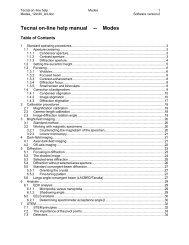
![Read more [PDF] - IFM - Linköping University](https://img.yumpu.com/51852190/1/184x260/read-more-pdf-ifm-linkoping-university.jpg?quality=85)
